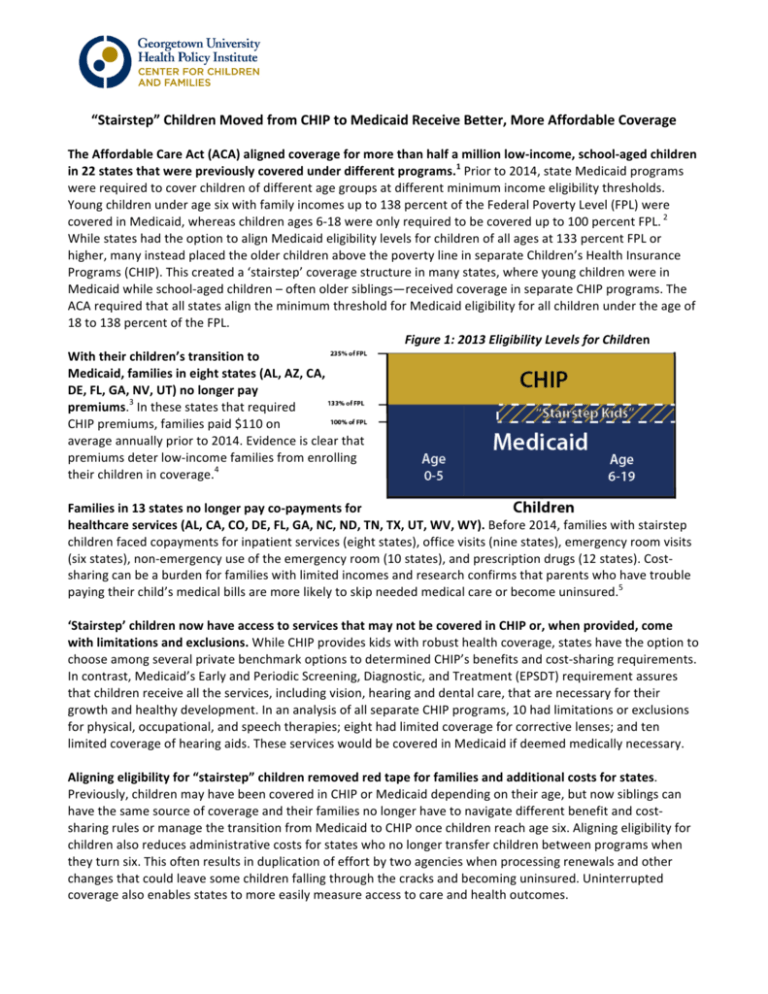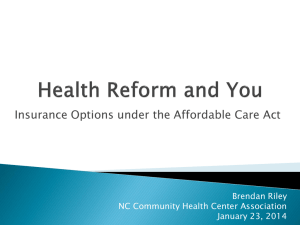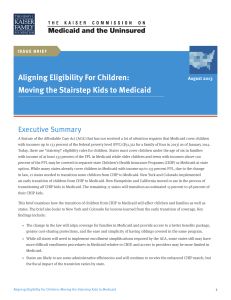Stairstep Kids - Center For Children and Families
advertisement

“Stairstep” Children Moved from CHIP to Medicaid Receive Better, More Affordable Coverage The Affordable Care Act (ACA) aligned coverage for more than half a million low-­‐income, school-­‐aged children in 22 states that were previously covered under different programs.1 Prior to 2014, state Medicaid programs were required to cover children of different age groups at different minimum income eligibility thresholds. Young children under age six with family incomes up to 138 percent of the Federal Poverty Level (FPL) were covered in Medicaid, whereas children ages 6-­‐18 were only required to be covered up to 100 percent FPL. 2 While states had the option to align Medicaid eligibility levels for children of all ages at 133 percent FPL or higher, many instead placed the older children above the poverty line in separate Children’s Health Insurance Programs (CHIP). This created a ‘stairstep’ coverage structure in many states, where young children were in Medicaid while school-­‐aged children – often older siblings—received coverage in separate CHIP programs. The ACA required that all states align the minimum threshold for Medicaid eligibility for all children under the age of 18 to 138 percent of the FPL. Figure 1: 2013 Eligibility Levels for Children With their children’s transition to Medicaid, families in eight states (AL, AZ, CA, DE, FL, GA, NV, UT) no longer pay premiums.3 In these states that required CHIP premiums, families paid $110 on average annually prior to 2014. Evidence is clear that premiums deter low-­‐income families from enrolling their children in coverage.4 Families in 13 states no longer pay co-­‐payments for healthcare services (AL, CA, CO, DE, FL, GA, NC, ND, TN, TX, UT, WV, WY). Before 2014, families with stairstep children faced copayments for inpatient services (eight states), office visits (nine states), emergency room visits (six states), non-­‐emergency use of the emergency room (10 states), and prescription drugs (12 states). Cost-­‐ sharing can be a burden for families with limited incomes and research confirms that parents who have trouble paying their child’s medical bills are more likely to skip needed medical care or become uninsured.5 ‘Stairstep’ children now have access to services that may not be covered in CHIP or, when provided, come with limitations and exclusions. While CHIP provides kids with robust health coverage, states have the option to choose among several private benchmark options to determined CHIP’s benefits and cost-­‐sharing requirements. In contrast, Medicaid’s Early and Periodic Screening, Diagnostic, and Treatment (EPSDT) requirement assures that children receive all the services, including vision, hearing and dental care, that are necessary for their growth and healthy development. In an analysis of all separate CHIP programs, 10 had limitations or exclusions for physical, occupational, and speech therapies; eight had limited coverage for corrective lenses; and ten limited coverage of hearing aids. These services would be covered in Medicaid if deemed medically necessary. Aligning eligibility for “stairstep” children removed red tape for families and additional costs for states. Previously, children may have been covered in CHIP or Medicaid depending on their age, but now siblings can have the same source of coverage and their families no longer have to navigate different benefit and cost-­‐ sharing rules or manage the transition from Medicaid to CHIP once children reach age six. Aligning eligibility for children also reduces administrative costs for states who no longer transfer children between programs when they turn six. This often results in duplication of effort by two agencies when processing renewals and other changes that could leave some children falling through the cracks and becoming uninsured. Uninterrupted coverage also enables states to more easily measure access to care and health outcomes. 1 W. Prater and J. Alker, “Aligning Eligibility for Children: Moving the Stairstep Kids to Medicaid” Kaiser Commission on Medicaid and the Uninsured (August 2013), available at http://ccf.georgetown.edu/wp-­‐content/uploads/2013/08/stair-­‐step.pdf Note: CA and NH were required to move their ‘stairstep’ children under the ACA, but decided to move all of their children from separate CHIP programs into Medicaid before 2014. CA moved their children in 2013, and NH transitioned in 2011. 2 Poverty guidelines are shown for 2013 to reflect when stairstep policies were enacted. In addition, though statute sets eligibility at 133 percent FPL, the ACA established a five percent income disregard in for eligibility determinations, effectively making the eligibility level 138 percent FPL. 3 The Georgetown Center for Children and Families will publish a forthcoming paper on stairstep eligibility. Data reported in this brief are based on analysis of jointly written publications on children’s benefits and cost-­‐sharing in Medicaid and separate CHIP programs. For example see, Georgetown University Center for Children and Families and National Academy for State Health Policy, “Benefits and Cost Sharing in Separate CHIP Programs,”(May 2014), available at http://ccf.georgetown.edu/ccf-­‐resources/benefits-­‐and-­‐cost-­‐sharing-­‐in-­‐ separate-­‐chip-­‐programs/. 4 See for example L. Dague, “The effect of Medicaid premiums on enrollment: A regression discontinuity approach,” Journal of Health Economics, 37:1-­‐12 (September 2014), available at http://www.sciencedirect.com/science/article/pii/S0167629614000642. 5 S. McMorrow, et al., “Trade-­‐Offs Between Public and Private Coverage for Low-­‐Income Children have Implications for Future Policy Debates,” Health Affairs 33: 1367-­‐1374 (August 2014), available at http://content.healthaffairs.org/content/33/8/1367.full.pdf+html.







